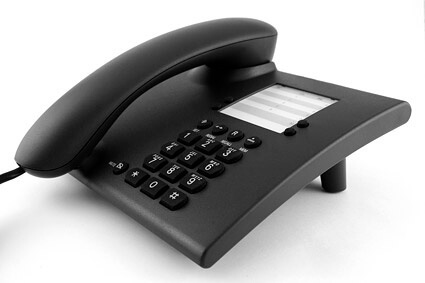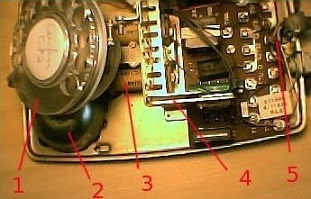What is a Telephone?A telephone or simply referred to as a phone, is a device that sends and receives sound across a certain distance. A telephone's primary job is to transform analogue sounds into electrical signals that may be transmitted to other phone users. The name telephone comes from the Greek roots tele, which has a meaning of phone and afar that means sound or voice. The main credit for inventing the telephone is Alexander Graham Bell in 1876. It makes people capable of communicating with others over almost any distance. 
One of the most instant and widespread forms of communication is telephone communication. In order to exchange information in all areas of human life, the telephone has proved to be invaluable. It can be used in many different areas, such as social contacts, business, science, personal services, government, or public health. In 1887, there were around 200,000 telephones in the world, and in 1928, about 30 million, and in 1958, approximately 118 million, and over 330 million in 1995. According to the University of California at Berkeley, there were around 1.3 billion main telephone lines in use worldwide in 2004. The concept of the telephone as a system entails a number of elements. The telephone equipment itself is the first element. Then there are several types of apparatus for transmitting electromagnetic signals over long distances. Third, because the transmission lines are organised in multi-leveled structures, they can interconnect any desired telephone set upon request. Finally, signalling facilities are available for informing the individual who has been contacted, controlling switching operations, and clearing the circuits after the call has been completed. Telephony is a scientific and technological discipline that aids in the development of all of the telephone system's parts. Telephone NetworkThe structure of the telephone network may be described in terms of whole plant connections available between telephone exchanges. The three broad categories, long-haul networks, exchange area, and local, are included in the telephone network. The local network functions for linking telephones in businesses and residences to a central office in order to serve a specific geographical area. The size may be different in the cities and country. In cities, it can be 11.5 sq mi and 123.5 sq mi in the country. Local lines or loops are telephone lines that connect a subscriber to the central office. Central offices are linked through the exchange area network. The telephone connections that connect one telephone exchange to another are known as trunks in North America and junctions in Europe. For indicating the location in the system, every telephone is assigned a number. The switching network identifies that the call is initiating from which telephone and from which is receiving the call. For a signal path, it sets up the circuit connection from this information. Parts of a telephoneA telephone is a complete system, not just a thing, which only sits on the table at home. A whole slew of communication devices, including the cable that runs through the wall and the handset on your end that sends phone signals all over the country. Additionally, some switching equipment aids in the proper routing of calls. Let's take an example of a typical phone handset. In this handset, a loudspeaker located at the top, you press it against your ear. A microphone is situated near the user's mouth at the bottom of the telephone system. Two pairs of copper wires are included with a single thick, coiled cable that comes out of the handset. The output pair is in charge of transmitting electrical signals from the microphone to the telephone system. The input pair is responsible for taking incoming signals from the telephone system and sending them to the speakers. What's inside an antique telephone?

Quality of Telephone CommunicationThe essential requirements for high-quality telephone transmission are audibility, naturalness, and intelligibility of conveyed speech. These criteria are essentially the harmonic components of the human voice. The network structure has a significant impact on the quality of telephone service because it is fully dependent on the network structure to which subscribers are connected. As compared to the total amount of subscribers, the number of subscribers making a call telephone call in one go is always less. This is the fundamental reason why, when comparing the number of subscribers served by a central office to the number of channels in the commercial telephone system, the number of customers served by a central office is much smaller. Due to this kind of design, when the telephone traffic is high, a connection may be blocked. To prevent the occurrence of channel overload, good planning based on statistical analysis is used. Increasing the number of channels that can be carried by a single underlying medium is another technique to increase network quality. For instance, 600 voice channels could be carried by a coaxial cable in 1940. By the early 1950s, the number of speech channels had risen to 1,860, and by the 1980s, it had risen to 13,200. The microwave radio system saw a comparable expansion in bandwidth; in the 1950s, there were 2400 channels, which expanded to 42,000 channels in the 1980s. In this direction, fiber optic technology promises to offer even faster progress. The invention of the telephoneThe story of Alexander Graham Bell is controversial in terms of inventing telephones; however, he is generally credited with inventing telephones. Bell's mother was deaf; this was a reason that became Bell interested in sound and speech. His father and grandfather have extensive experience teaching deaf individuals, and as a result, they are considered experts in the field. Also, before making Bell's name as an inventor, he became an of the deaf people. But at the same time, like Bell, some other inventors were also working on the idea of making the telephone. For example, mere hours after Bell filed his own patent application, Elisha Gray (1835-1901) filed a patent on a comparable innovation. Antonio Meucci, a third inventor, came before either Bell or Gray. He is said to have invented the telephone in the 1840s. When the US Congress passed a bill in his honor, finally his contribution was recognized in 2002. Types of phonesSmartphones, cordless or wireless phones, regular mobile phones, and classic corded phones are the four main types of phones (uses a rotary dial or has buttons). Cell phones and smartphones have mostly supplanted the landline telephone in modern times. This is because smartphones and cell phones provide better service, as well as their prices have come down drastically. How to connect a landline phoneStandard house phones are connected to a wall with the help of an RJ-11 connector. When connecting a phone to a modem, the phone connects to the "line out" connector. From there, the landline connects to the "line in" connector of the modem. What does a telephone exchange do?The term "telephone exchanges" has been used several times without elaborating on what they perform or how they operate. Assume, in the street, there are five people. They want to chat with each other; therefore, they need telephones. Actually, it is easier to wire some baked bean cans. A connection is needed for all people to connect with all of the others, but that means there is a very complicated mess; here are requirements for four lines stretching and four baked bean cans in each home. We might be able to live with it, but it isn't ideal. Assume there are 5,000 people in your community who all wish to talk to each other. There would be needed 4999 lines for each house. And, think about if there are more than 10 million people in the city and they all want to talk with each other. This is why telephone exchanges come into use. Rather than being linked to everyone else, everyone is connected to their local exchange, which is connected to the other exchanges. In the above example, only one line is needed by four people, and the exchange would have the potential to provide a connection between any pair of them. In another example, only one line is still needed by 10 million people. But there is a need to add more local exchanges when the number of people increases. And, now one person is not connecting with another, but one person is connecting with another local exchange through their local exchange (a potentially a series of exchanges). Any connection between one line and another is not permanent. When there was less of a rush of people using the telephone, it was much easier for operators at telephone exchanges to manually keep track of the calls; they used to accomplish this by plugging leads in and out of switchboards. But as people came to expect faster calls and the size of the system was rapidly increased, it became difficult. Also, if anyone thinks that the invention of telephones was first before exchanges, he would be wrong. Exchanges for the telegraph were implemented a few years before Bell patented his phone, therefore the basic notion of central switching offices emerged before. This concept aided in the exchange of electrical messages between locations. Making international callsOnce, from one phone to another, all calls were carried down wires. This was a reason; long-distance calls were more expensive to make and took longer to route. While making an international call, the delay time was much between you and the person who is another end; that's why international calls took so long to route. This was because of the time for signals to travel down the wire. Now, there are a variety of different ways to travel the calls; however, most calls still travel from homes to local exchanges with old-style copper wires. But calls have the potential to go between exchanges down ultra-fast cables. Also, with the help of using microwave towers, longer-distances calls are often beamed between urban centers. Typically, international calls are bounced all over the world with the help of using space satellites. Microwave towers, fiber-optics, and satellites transmit and receive phone calls as pulses of electromagnetic radiation travelling at the speed of light, rather than as electrical impulses. Therefore, as compared to before, modern international phone calls are more reliable, much cheaper, and faster. Additionally, now calls took very little time to connect.
Next TopicWhat is Flash
|
 For Videos Join Our Youtube Channel: Join Now
For Videos Join Our Youtube Channel: Join Now
Feedback
- Send your Feedback to [email protected]
Help Others, Please Share










